
Clinical Oral Investigations
Scope & Guideline
Elevating clinical practices through rigorous research.
Introduction
Aims and Scopes
- Clinical Effectiveness in Dental Procedures:
Research that evaluates the effectiveness of various dental procedures, treatments, and technologies, including comparative studies on restorative materials, surgical techniques, and treatment outcomes. - Oral Disease Pathogenesis:
Studies exploring the mechanisms underlying oral diseases, including microbiological, immunological, and genetic factors that contribute to conditions such as periodontitis, dental caries, and oral cancers. - Innovations in Dental Materials:
Investigations into new dental materials and technologies, including the development and assessment of bioactive materials, adhesives, and restorative techniques, addressing their mechanical properties and clinical applicability. - Interdisciplinary Approaches to Oral Health:
Research that integrates perspectives from various disciplines, such as medicine, pharmacology, and public health, to address complex oral health issues and improve patient outcomes. - Patient-Centered Outcomes and Quality of Life:
Studies focused on the impact of dental treatments and oral health conditions on patients' quality of life, including psychosocial factors and patient-reported outcomes. - Preventive and Non-Surgical Treatments:
Research on preventive measures against oral diseases and non-surgical approaches to manage conditions such as periodontal disease, emphasizing minimally invasive techniques. - Technological Advances in Dentistry:
Studies that evaluate the use of digital technologies in dentistry, including 3D imaging, computer-assisted design and manufacturing, and artificial intelligence applications.
Trending and Emerging
- Digital Dentistry and Technology Integration:
There is a growing emphasis on digital dentistry, including the use of intraoral scanners, CAD/CAM technologies, and AI applications, reflecting the industry's shift towards more efficient and precise dental practices. - Regenerative Dentistry:
Research focused on regenerative approaches, including the use of stem cells, growth factors, and bioactive materials for tissue engineering and repair, is gaining traction, highlighting a shift towards biological and regenerative therapies. - Microbiome Research in Oral Health:
An increasing number of studies are exploring the oral microbiome's role in health and disease, particularly its impact on periodontal disease and systemic health, indicating a trend towards understanding the interconnections between oral and overall health. - Patient-Centered Research:
There is a notable rise in studies focusing on patient-reported outcomes, quality of life assessments, and the psychosocial aspects of oral health, emphasizing a more holistic approach to dental care. - Tele-dentistry and Remote Care:
Emerging interest in tele-dentistry reflects the adaptation to digital health solutions, especially in light of the COVID-19 pandemic, which has accelerated the need for remote consultations and treatment planning. - Biomaterials and Bioengineering:
Research on novel biomaterials, including those that promote healing and have antimicrobial properties, is on the rise, pointing towards advancements in material science that enhance dental treatments.
Declining or Waning
- Traditional Surgical Techniques:
There is a noticeable decline in studies focusing solely on traditional surgical methods without integration of newer technologies or minimally invasive approaches, as the field moves towards more innovative and less invasive treatments. - Invasive Dental Treatments:
Research centered on highly invasive dental procedures is waning, as there is increasing emphasis on conservative and preventive strategies in oral health management. - Pharmacological Interventions for Pain Management:
The volume of studies dedicated to traditional pharmacological pain management in dentistry is diminishing, likely due to a growing focus on holistic and alternative approaches such as non-pharmacological therapies. - Single-Center Studies:
There is a trend away from isolated single-center studies towards multi-center collaborations, reflecting a shift in the need for diverse population samples and broader applicability of findings. - Descriptive Epidemiological Studies:
The prevalence of purely descriptive studies on oral health epidemiology is declining, as researchers increasingly seek to connect findings to interventions and outcomes.
Similar Journals
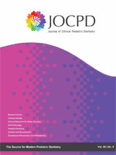
Journal of Clinical Pediatric Dentistry
Connecting research and practice for healthier smiles in kids.Journal of Clinical Pediatric Dentistry, published by MRE PRESS, is a vital resource in the fields of Dentistry, Pediatrics, and Medicine, with a history dating back to 1990. This peer-reviewed journal, identified by ISSN 1053-4628 and E-ISSN 1557-5268, aims to disseminate important research findings, clinical practices, and advancements in pediatric dental care, making it essential reading for researchers, practitioners, and students committed to improving oral health in children. With a current impact factor placing it in the Q3 category across multiple disciplines, the journal is ranked 75 out of 132 in General Dentistry and 191 out of 330 in Pediatrics, highlighting its relevance and the quality of work being published. While the journal operates on a subscription model, its credible content, encompassing vital studies and clinical guidelines, promotes a deeper understanding of pediatric dental health, ultimately striving for better health outcomes for children worldwide. As it converges towards its future with anticipation for contributions until 2024, the Journal of Clinical Pediatric Dentistry continues to foster an academic dialogue that shapes best practices in the field.

Journal of International Oral Health
Exploring Innovations in Dental ScienceThe Journal of International Oral Health, published by Wolters Kluwer Medknow Publications, is a pivotal forum in the field of dentistry, particularly for those engaged in global oral health developments. With an ISSN of 0976-7428 and an E-ISSN of 0976-1799, this journal serves to disseminate significant research findings, innovative practices, and advancements in dental science. Recognized in 2023 with a Q3 ranking in the miscellaneous category of dentistry, it currently holds a respectable position among its peers, being ranked 98 out of 132 in general dentistry by Scopus, reflecting its growing influence in the discipline. With a dedication to enhancing oral health knowledge and practices, the journal welcomes contributions from researchers, professionals, and students alike, providing an accessible platform for exploration and dialogue. Although it primarily operates within a non-open access model, its expansive coverage of oral health topics, converging from 2016 to 2024, makes it an indispensable resource for those aiming to stay informed and engage with contemporary oral health issues, especially within the context of India and beyond.
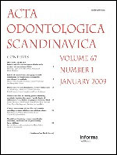
ACTA ODONTOLOGICA SCANDINAVICA
Bridging Research and Practice for a Healthier Smile.ACTA ODONTOLOGICA SCANDINAVICA, published by Medical Journal Sweden AB, is a prestigious journal in the field of dentistry and medicine, embedded in the rich tradition of dental research since its inception in 1939. With its E-ISSN 1502-3850, the journal aims to disseminate high-quality research that contributes to the latest advancements in oral health, bridging clinical practice and scientific inquiry. The journal currently holds a Q2 classification in both Dentistry and Medicine according to the 2023 category quartiles, positioning it competitively within its academic domain. It is well-regarded for its rigorous peer-review process and contributes significantly to the global discourse on dental treatments and innovations. Researchers, clinicians, and students can access a wide array of articles that cover various facets of dental science, informing best practices and stimulating future research endeavors. With an emphasis on interdisciplinary collaboration, ACTA ODONTOLOGICA SCANDINAVICA continues to be a vital resource for anyone passionate about oral health and its implications in general medicine.
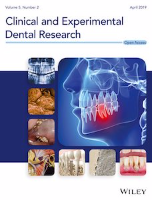
Clinical and Experimental Dental Research
Championing high-quality research for the dental community.Clinical and Experimental Dental Research, published by WILEY, is a premier open access journal dedicated to advancing the field of dentistry through the dissemination of high-quality research. With an ISSN of 2057-4347, this journal has been making significant strides in the dental community since its establishment in 2015. It is particularly noteworthy for its impact factor and ranking, categorized as Q2 in the miscellaneous dentistry field, and holding a position of Rank #58 out of 132 in general dentistry according to Scopus, reflecting its commitment to excellence in scholarly publishing. The journal aims to provide a platform for innovative research that explores both clinical practice and experimental studies in dental science, thereby fostering knowledge exchange among researchers, professionals, and students. It is accessible globally, ensuring that cutting-edge findings are available to a wide audience! With its focus on multidisciplinary approaches and collaboration within dentistry, Clinical and Experimental Dental Research plays a vital role in shaping the future of dental health and research methodologies.
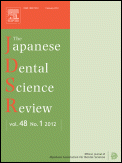
Japanese Dental Science Review
Exploring the forefront of dental science and practice.Japanese Dental Science Review, published by ELSEVIER SCI LTD, is a premier open-access journal dedicated to advancing the field of dentistry. With an impressive impact factor and a status of Q1 in the field of Dental Sciences, it ranks among the top journals globally, securing Rank #4 out of 132 in General Dentistry per Scopus, placing it in the 97th percentile. This journal, with the ISSN 1882-7616 and E-ISSN 2213-6851, has been a vital resource for researchers, practitioners, and students since its inception in 2008, offering unrestricted access to cutting-edge research and reviews that cover a broad spectrum of topics within dentistry. With a commitment to fostering knowledge sharing and innovation, the Japanese Dental Science Review is an essential platform for those looking to stay at the forefront of dental research and practice in the ever-evolving landscape of oral health.

Oral Health & Preventive Dentistry
Championing excellence in dental hygiene research.Oral Health & Preventive Dentistry is a premier Open Access journal dedicated to advancing the field of dental hygiene and oral health through innovative research and evidence-based practices. Published by QUINTESSENCE PUBLISHING CO INC, this journal has established itself as a key resource for researchers, clinicians, and students since its inception in 2003, continuing to contribute valuable insights with a convergence through 2024. With an impressive Scopus ranking of #2 out of 7 in the category of Dentistry and Dental Hygiene, it sits in the 78th percentile, showcasing its impact and relevance in contemporary dental research. The journal's Open Access model, implemented in 2020, offers widespread dissemination of knowledge, ensuring that cutting-edge findings reach a global audience. By focusing on crucial aspects of oral health prevention, Oral Health & Preventive Dentistry plays a vital role in the ongoing dialogue about effective dental practices, public health initiatives, and the enhancement of patient care.
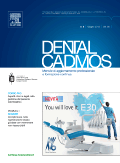
Dental Cadmos
Innovating the future of oral health research.Dental Cadmos is a respected journal in the field of dentistry, focusing on areas such as Oral Surgery and Orthodontics. Published by EDIZIONI EDRA, this journal has been a vital resource for the dental community since its inception, with publication years spanning from 1965 to 1991 and 2007 to 2024. With a current categorization in the Q4 quartile for both Oral Surgery and Orthodontics, and notable Scopus rankings that reflect its standing within the dental field, the journal aims to disseminate innovative research, clinical practices, and case studies that advance the science of dentistry. Although it does not offer open access, it is crucial for researchers and professionals looking to keep abreast of contemporary developments. The journal is based in Milan, Italy, contributing valuable insights to the global dental landscape. Whether you are a practitioner, researcher, or student, Dental Cadmos is an essential platform for both foundational knowledge and pioneering advancements in the oral health domain.
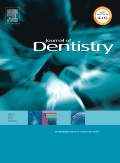
JOURNAL OF DENTISTRY
Advancing the Future of Dental Science.JOURNAL OF DENTISTRY, published by Elsevier Science Ltd, stands as a leading peer-reviewed journal in the field of dentistry, boasting an impressive impact factor and ranking in the top 10 of the Scopus category for general dentistry. Operating since 1972, this esteemed publication provides a comprehensive platform for the dissemination of research, reviews, and clinical findings across the spectrum of dental sciences. With a Q1 ranking for 2023, it is recognized for its significant contribution to advancing the field of dentistry, offering valuable insights for researchers, practitioners, and students. Although it does not currently offer Open Access options, the journal's rigorous editorial standards and commitment to quality make it a pivotal resource for anyone involved in dental research and practice. Residing in the Netherlands and dedicated to fostering innovation in dental science, JOURNAL OF DENTISTRY is an essential read for those aiming to stay at the forefront of dental developments.
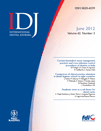
INTERNATIONAL DENTAL JOURNAL
Leading the Way in Global Dental ResearchINTERNATIONAL DENTAL JOURNAL, published by Elsevier, stands as a leading peer-reviewed journal in the field of dentistry, dedicated to advancing oral health research and clinical practices. With an impressive impact factor reflected in its Q1 category ranking in Dentistry (miscellaneous), it ranks 28th out of 132 journals in the general dentistry category, placing it in the 79th percentile. Established in the 1960s and operating as an Open Access journal since 2021, it provides unfettered access to cutting-edge research, thereby promoting knowledge dissemination among researchers, practitioners, and students alike. The journal encompasses a broad range of topics within dentistry, including clinical studies, innovative treatments, public health initiatives, and educational methodologies. Located in Amsterdam, Netherlands, this journal continually contributes significantly to the global dental community, ensuring that the latest scientific advancements and practical insights are readily available to enhance dental care worldwide.

Contemporary Clinical Dentistry
Exploring the Frontiers of Dental ScienceContemporary Clinical Dentistry, published by Wolters Kluwer Medknow Publications, is a pioneering open-access journal that has been disseminating high-quality research in the field of dentistry since 2010. With an ISSN of 0976-237X and E-ISSN 0976-2361, this journal serves as a valuable platform for sharing innovative findings across multiple dental specialties, including Oral Surgery, Orthodontics, and Periodontics. As evidenced by its Q3 ranking in these categories for 2023 and its Scopus rankings indicating a competitive presence in the field, Contemporary Clinical Dentistry plays a crucial role in advancing clinical practices and fostering collaboration among dental professionals. Based in India, the journal is committed to enhancing access to vital research through its open-access model, ensuring that researchers, practitioners, and students can readily engage with the latest advancements in the dental sciences. With a broad scope aimed at bridging the gap between academia and clinical practice, the journal not only contributes to the global conversation in dentistry but also empowers professionals to apply research insights effectively in their practice.